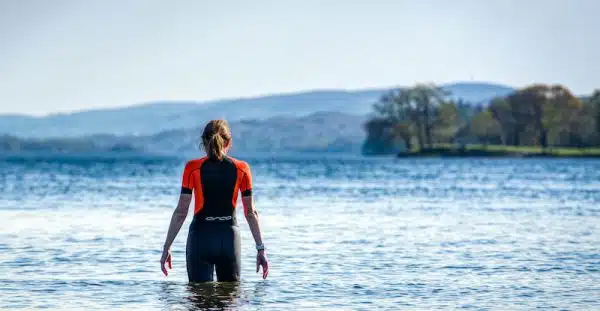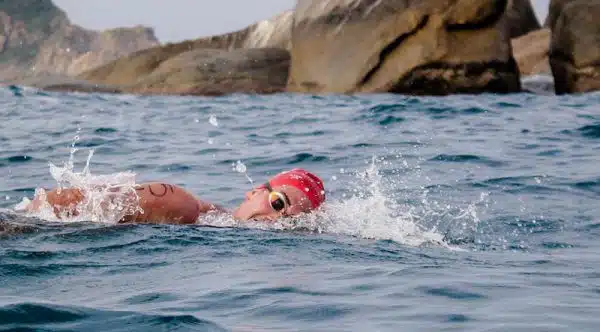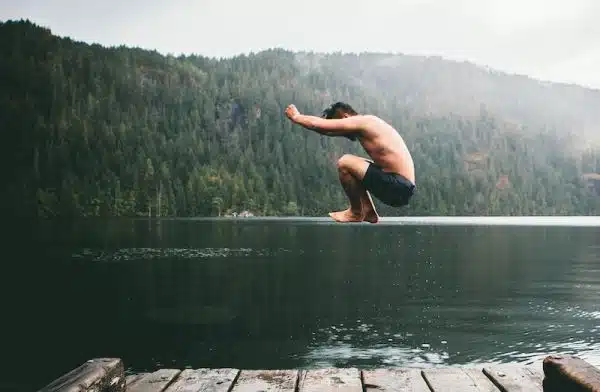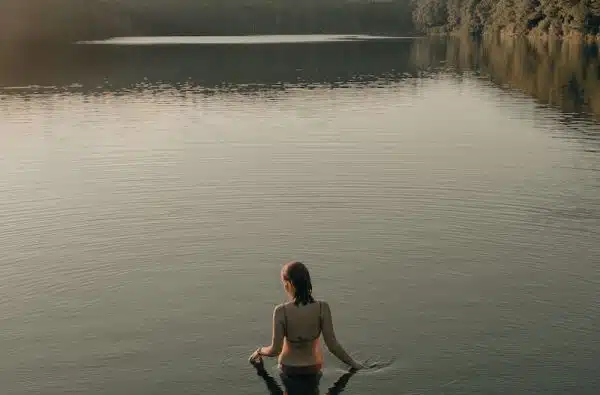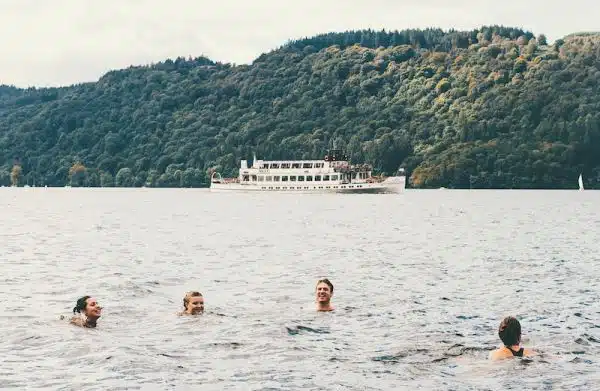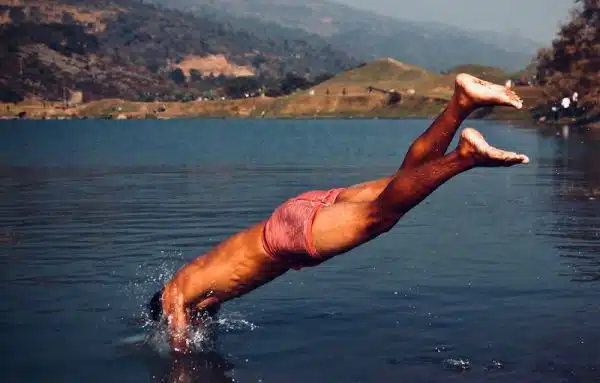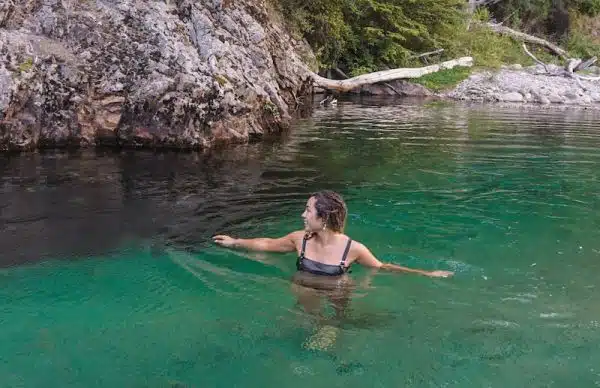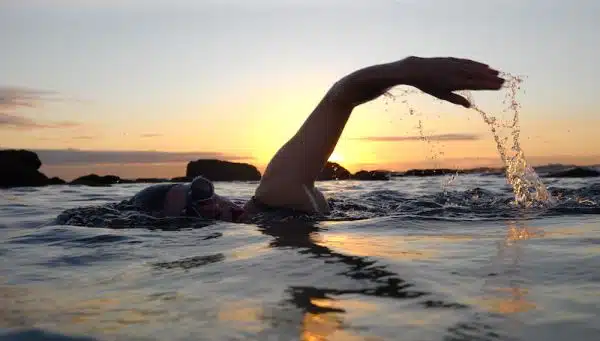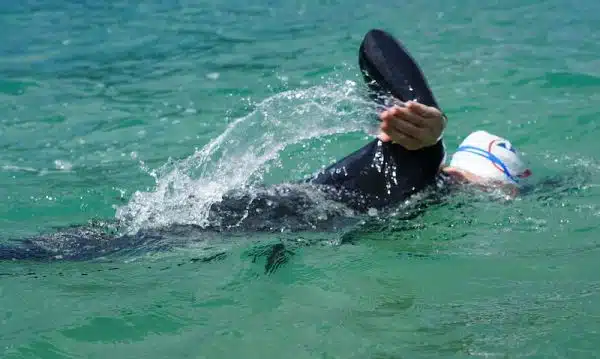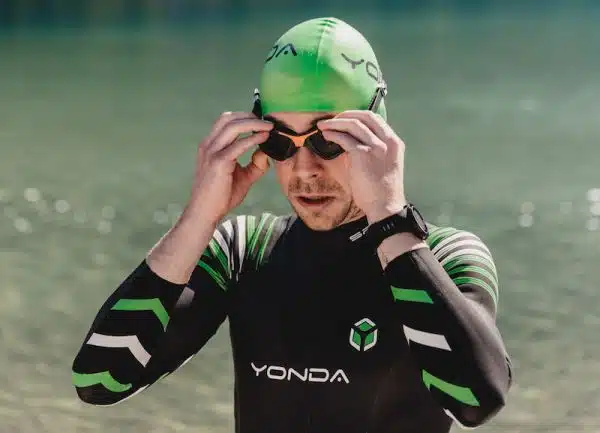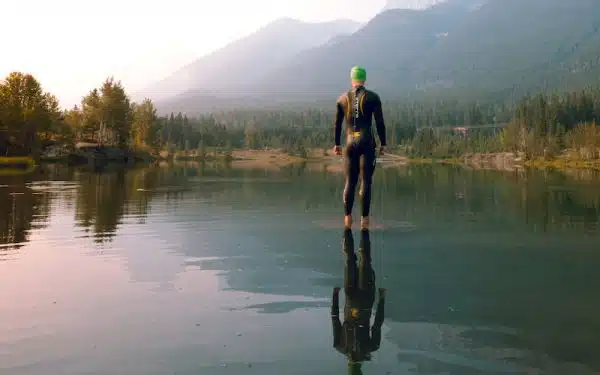Wild swimming, or open water swimming as it is sometimes known, is an invigorating outdoor activity that can be enjoyed by all ages and abilities. Wild swimming is a great way to get outside and enjoy the natural environment. Outdoor swimmers also benefit from improved physical health and mental wellbeing. Not to mention it’s fun!
Getting started with wild water swimming may seem a bit daunting but this article is here to help. The UK is blessed with many great locations for wild swimming and if you follow our advice you will soon be safely enjoying open water swimming.
What is Wild Swimming?
Wild swimming, also known as open water swimming, is swimming in natural bodies of water such as rivers, lakes, ponds, or even the ocean, as opposed to swimming in man-made pools. It embraces the spirit of adventure and exploration, offering a refreshing alternative to traditional swimming experiences. Unlike swimming in controlled environments, wild swimming immerses swimmers in unchlorinated water, allowing them to connect with nature and experience the raw beauty of natural landscapes.
This invigorating activity encompasses a wide range of experiences, from leisurely dips in secluded waterholes to challenging long-distance swims in open seas. Wild swimming provides a unique opportunity to escape the confines of conventional swimming settings and embrace the freedom and untamed allure of the great outdoors.
Best Wild Swimming Near Me:
This is a list of places in the UK you can safely go open water swimming. They are all suitable for beginners as well as more experienced wild swimmers. For a more detailed guide to these wild swimming locations please click the regional headings below to find a wild swimming spot near you.
Map of Wild Swimming Locations
To help you locate the best locations to go wild swimming near you, we have created this handy map. As you can see, there’s lots of places in the UK to dive in and enjoy a swim in fresh water.
London
Welcome to the surprising world of wild swimming in London! Despite being a bustling metropolis, London offers unique opportunities for adventurous swimmers. Dive into the city’s historic waterways like the River Thames or discover hidden gems such as Hampstead Heath’s bathing ponds. These serene oases provide a refreshing escape from the urban chaos. Remember to follow safety guidelines and respect the environment. So, whether you’re a Londoner or a visitor, grab your swimsuit, embrace the unexpected, and indulge in the exhilaration of wild swimming right in the heart of the city.
-
Beckenham Place Park, Greater London, BR3 5BS
-
The Royal Docks, London, E16 1AH
-
Parliament Hill Fields Lido, Greater London, NW5 1LT
-
West Reservoir Water Sports Centre, Hackney, N4 2HA
-
Hampstead Heath Bathing Ponds, Camden, NW3 1BP
-
Merchant Taylors’ Lake, Hertfordshire, HA6 2HT
-
Shepperton Open Water Swim, Middlesex, TW17 9LH
South East England
The South East of England offers a wealth of stunning waterways, perfect for adventurous swimmers. Immerse yourself in the sparkling waters of scenic lakes and explore hidden river pools nestled amidst idyllic landscapes. From the historic beauty of the Thames to the charming lakes of Hampshire, the South East boasts a diverse range of wild swimming locations.
-
Caversham Lakes, Reading, RG4 9RA
-
Liquid Leisure Windsor, Berkshire, SL3 9HY
-
Horseshoe Lake Activity Centre, Berkshire, GU47 8JW
-
Andark Lake, Southampton, Hampshire, SO31 7EG
-
Ellingham Open Water Swim, Hampshire, BH24 3PJ
-
Queenford Lakes, Oxfordshire, OX10 7PQ
-
Hawley Lake, Hampshire, GU17 9UD
-
Heron Lake, Berkshire, TW19 6HW
-
Hedgecourt Lake, Surrey, RH19 2QG
South West England
With its stunning coastline, idyllic rivers, and hidden coves, the South West of England offers a paradise for adventurous swimmers. Dive into the crystal-clear waters of secluded quarries, explore river pools surrounded by lush countryside, or enjoy the challenge of swimming in a lake. From the rugged landscapes of Cornwall to the charming beauty of Devon, the South West provides an abundance of wild swimming opportunities.
-
Cromhall Quarry, Gloucestershire, GL12 8AA
-
Clevedon Marine Lake, North Somerset, BS21 7TU
-
Vobster Quay, Somerset, BA3 5SD
-
Lake 32 Outdoor Centre, Cirencester, Gloucestershire, GL7 6DF
-
Swineham Lake, Dorset, BH20 4JD
-
Bude Sea Pool, Cornwall, EX23 8HJ
-
Sharrah Pool, Dartmoor, Devon, TQ13 7NT.
-
Chagford Lido, Dartmoor, Devon, TQ13 8DA
East of England
The East of England is a hidden treasure for adventurous swimmers. Immerse yourself in the refreshing waters of picturesque lakes nestled amidst stunning landscapes, explore the meandering rivers that wind through quaint villages, or dive into the inviting coastal waters. From the tranquil Norfolk Broads to the charming countryside of Suffolk, the East of England offers a diverse range of wild swimming spots.
-
Herts Young Mariners Base, Hertfordshire, EN8 9AJ
-
Redricks Lake, East Hertfordshire, CM21 1RL
-
Lake Ashmore, Cambridgeshire, PE28 9BP
-
Stanborough Park, Hertfordshire, AL8 6DF
-
Fritton Lake, Great Yarmouth, Norfolk, NR31 9HA
The Midlands
The Midlands of England are home to stunning waterways and hidden gems perfect for adventurous swimmers. Dive into the pristine lakes nestled within picturesque countryside, explore the meandering rivers that wind through lush green landscapes, or discover the tranquil reservoirs dotted across the region. From the idyllic Peak District to the charming canals of Birmingham, the Midlands offers a diverse range of wild swimming opportunities.
-
Aztec Adventure Upton Warren, Worcestershire. B61 7ER
-
University of Worcester Lakeside Campus, Worcestershire, WR6 6NH
-
Netherton Reservoir, West Midlands, DY2 0HL
-
Combs Reservoir, East Midlands, SK23 9UH
-
Race Hub @ Frisby Lake, Leicestershire, LE14 3TL
-
The Falcon, Castle Ashby, Northampton, NN7 1LF
-
Hoveringham Lake, Nottingham, NG14 7J
Yorkshire and the Humber
Yorkshire is brimming with stunning water bodies, offering fantastic opportunities for adventurous swimmers. Dive into the crystal-clear waters of picturesque lakes, swim under waterfalls and explore hidden river pools surrounded by breathtaking landscapes. From the majestic Yorkshire Dales to the charming seaside towns, Yorkshire and the Humber provide an array of wild swimming locations to suit every taste.
-
Allerthorpe Lakeland Park, Pocklington, York, YO42 4RL
-
Hatfield Water Park, South Yorkshire, DN7 6EQ
-
Thrybergh Country Park, Rotherham, South Yorkshire, S65 4NU
-
Welton Waters Adventure Centre, East Riding of Yorkshire, HU15 1PT
-
Bolton Abbey, North Yorkshire, BD23 6EX
-
Loup Scar, North Yorkshire, BD23 6BS
-
Catrigg Force, North Yorkshire, BD24 9PZ
-
Stainforth Force, North Yorkshire, BD24 0DP
-
Janet’s Foss, North Yorkshire, BD23 4DL
North West England
With its diverse landscapes and breathtaking water bodies, the North West of England is a haven for adventurous swimmers. Dive into the cool waters of stunning lakes, explore hidden river pools nestled within picturesque valleys, or discover the beauty of the rugged coastline. From the serene Welsh Borders to the vibrant city of Manchester, North West England offers a wealth of wild swimming opportunities.
-
Pennington Flash, Greater Manchester, WA3 1BQ
-
Sale Water Park, Greater Manchester, M33 2LX
-
Boundary Water Park, Cheshire, CW4 8HT
-
Knutsford Mere, Cheshire, WA16 6LJ
-
Capernwray Diving Centre, Lancashire, LA6 1AD
-
Wyresdale Park, Preston, Lancashire PR3 1BA
-
Salford Water Sports Centre, Greater Machester, M50 3SQ
Lake District
There are lots of places you can go wild swimming in the Lake District. The bigger, more popular lakes are busier and have lots of boats and water sports and they are very, very cold. The smaller lakes are much better for swimming and as they are shallower they tend to be a bit warmer. You are not allowed to swim in Ennerdale Water, Haweswater reservoir, Thirlmere reservoir and Kentmere reservoir and please be aware that there are problems with algae blooms on some of the lakes.
-
Buttermere, Cumbria, CA13 9UZ
-
Crummock Water, Cumbria, CA13 9UY
-
Grasmere, Cumbria, LA22 9PZ
-
Loweswater, Cumbria, CA13 0RU
-
Rydal Water, Cumbria, LA22 9SE
-
Loughrigg Tarn, Cumbria, LA22 9HF
North East England
North East England is blessed with an abundance of stunning water bodies that are perfect for adventurous swimmers. Dive into the refreshing waters of serene lakes, explore hidden river pools, or embrace the exhilaration of swimming along the rugged coastline. From the picturesque landscapes of Northumberland to the vibrant city of Newcastle, North East England offers a diverse range of wild swimming opportunities.
-
Sweethope Lough, Hexham, Northumberland, NE48 2TE
-
QE2 Lake, Woodhorn, Northumberland, NE63 9AT
-
Ladyburn Lake, Druridge Bay, Northumberland, NE61 5BX
-
River Tyne, Chollerford, Northumberland, NE46 4EW
-
Derwent Reservoir, County Durham, DH8 9PT
-
Preston Park, County Durham, TS18 3RH
-
Bishopton Lake, County Durham, TS21 1EY
-
Hetton Lyons, County Durham, DH5 9DT
-
Low Force, County Durham, DL12 0XF
-
Linhope Spout, Northumberland, NE66 4LZ
Scotland
People in Scotland are known to have the “right to roam” but this is not always clearly understood. Section 1 of the Land Reform (Scotland) Act 2003 grants the public the right to access land and inland water responsibly. This includes the right to engage in recreational activities like wild swimming. People can access and swim in rivers, lochs, and lakes, as long as they do not infringe on the rights of landowners or other users of the area. Local restrictions or bylaws may apply, so it’s crucial to be aware of any specific guidelines provided by landowners or local authorities to ensure a safe and respectful wild swimming experience. These are some of the best and safest places to go open water swimming in Scotland.
-
Fairy Pools, Isle of Skye, IV55 8WF
-
Loch Duntelchaig, Inverness, IV2 6TX
-
Willowgate Activity Centre, Perth, PH2 7JU
-
Loch Insh, Cairngorms, PH21 1NU
-
Loch Lomond, West Dunbartonshire, G83 8EG
-
Loch Morlich, Highlands, PH22 1QU
-
Witch’s Cauldron in Clunes, Highlands, PH34 4EJ
Wales
With its stunning landscapes and pristine waters, Wales offers a paradise for outdoor swimmers. Dive into crystal-clear lakes, plunge into meandering rivers, and discover hidden waterfalls. Immerse yourself in the natural beauty of Wales as you embrace the exhilarating freedom of wild swimming. But remember, always respect the environment, check local guidelines, and follow safety advice.
-
Llyn Padarn, Snowdonia National Park, Gwynedd, LL55 4TY
-
Llandegfedd Reservoir, Monmouthshire, NP4 0SY
-
Llys-y-Frân, Pembrokeshire, SA63 4RR<
-
Sgwd Gwladys (Lady Falls), Brecon Beacons, SA11 5NR
-
Llyn Gwynant, Gwynedd, LL55 4NW
-
The Blue Lagoon, Abereiddy, Pembrokeshire, SA62 6DT
-
Llyn Tegid (Bala Lake), Gwynedd, LL23 7NP
-
Park in the Past in Caergwrle, Wrexham, LL12 9HB
Ireland
With its picturesque lakes and meandering rivers, Ireland offers a haven for wild swimmers. Dive into the crisp, clear waters of a river or immerse yourself in the tranquility of freshwater lakes. Remember to respect the environment, follow local guidelines, and prepare for the ever-changing weather.
-
Carlingford Lough, County Louth
-
Mountshannon Beach, Lough Derg, County Clare
-
Lough Erne, County Fermanagh
-
Banagher Outdoor Pool, County Offaly
-
Loughrea Lake, County Galway
-
Belmullet Tidal Pool, County Mayo,
-
Peddlers Lake, County Kerry
Wild Swimming Guide
This comprehensive guide to wild Swimming takes you on a captivating journey into the heart of the world’s most enchanting and unspoiled swimming locations. It serves not only as an informative tool for beginners but also as an invaluable resource for experienced wild swimmers seeking new challenges. Whether you wish to plunge into serene lakes, glide through flowing rivers, or brave the ocean’s powerful waves, our guides are your trustworthy companion to an unforgettable wild swimming experience.
Wild Swimming in London and the South East of England
Wild Swimming in Wales and the South West of England
Wild Swimming in the Midlands and Yorkshire
Wild Swimming in Lake District and the North of England
Wild Swimming in Scotland and Ireland
What Are the Benefits of Cold Water Swimming?
One of the reasons for the popularity of wild swimming is the growing body of research showing how good it is for us. Here are some of the benefits of cold water swimming:
Physical Fitness:
Like any swimming, wild swimming is a fantastic, full-body workout. It engages almost every muscle group, can be as strenuous or as gentle as you like, and is generally easier on the joints than land-based exercise.
Mental Health:
Many wild swimmers report experiencing lower levels of stress and anxiety. Being in nature can have calming effects and the physical activity itself promotes the release of endorphins, our bodies’ “feel-good” hormones.
Boosts the Immune System:
Regular exposure to cold water can increase the level of white blood cells in your body, helping to boost your immune system and making you less susceptible to illnesses.
Increased Metabolism:
Swimming in colder water can increase your metabolism as your body has to work harder to keep warm, which can aid weight loss and improve cardiovascular health.
Improves Circulation:
The cold water can stimulate blood flow in your skin and extremities, enhancing overall circulation and promoting better oxygen supply throughout the body.
Connection with Nature:
Wild swimming offers a unique opportunity to connect with the great outdoors, experience different environments and gain a sense of adventure, which can be rewarding and invigorating.
Community:
The wild swimming community is very supportive, making it a great activity to meet new people, share experiences and create social bonds. There are lots of wild swimming clubs around the UK that welcome new members.
Is Open Water Swimming a Safe Activity?
Obviously, swimming in fresh water or the ocean presents hazards you would not encounter in the controlled environment of a pool. However, as long as you take sensible precautions wild water swimming is as safe as any other outdoor activity. Here are some of the potential dangers to consider:
Temperature:
One of the most significant risks of wild swimming is the cold. Entering cold water too quickly can lead to cold shock response, potentially causing loss of breath and increasing the risk of drowning. Hypothermia is also a concern if you stay in cold water for too long. It’s important to acclimatize to the water temperature gradually and monitor how long you’re swimming.
Currents and Tides:
Wild swimming often takes place in rivers and seas where currents can be strong, and tides can change rapidly. Always check local advice for the specific place and time you’re planning to swim.
Water Quality:
Freshwater bodies, especially stagnant ones, can carry harmful bacteria or parasites, while sea water may be polluted in certain areas. It’s important to ensure you’re swimming in clean, safe water, and avoid swallowing it if possible. The UK government provides two websites where you can check water quality:
https://www.gov.uk/quality-of-local-bathing-water
https://environment.data.gov.uk/bwq/profiles/
Visibility:
Unlike swimming pools, open waters don’t always have clear visibility. This can make it difficult to see underwater hazards like rocks or sudden changes in depth. Always scout the area first, and consider wearing goggles for better underwater visibility.
Wildlife:
Depending on where you swim, there could be wildlife to consider. For example, some rivers may contain aggressive species, while jellyfish could be a concern in certain seas.
Supervision and Safety Equipment:
It’s always safer to swim in a group or with a buddy, and in an area with lifeguards if possible. Using proper equipment like wetsuits, brightly coloured swim caps, and buoyancy aids can also increase safety.
It’s absolutely crucial to know your own abilities and limits, and never swim alone in unfamiliar waters. Check local conditions and weather forecasts, and always inform someone of your swimming plans. If you’re new to wild swimming, you might consider joining a local group or taking lessons from certified instructors.
So, yes, wild swimming can be safe, but it requires knowledge, preparedness, and respect for the power of nature. Safety should always be your top priority!
How to Prepare for Wild Swimming
Whether you are a beginner or an experienced outdoor swimmer there are some steps you should take before diving in. Here are some key precautions to consider:
Acclimatization:
Gradually expose your body to colder water to build up your tolerance. You might start with shorter swims in cooler, not cold, water and slowly extend your swim duration as your body adapts. Never jump into cold water abruptly – this can induce a cold shock response.
Appropriate Gear:
Consider wearing a properly fitted wetsuit, especially if the water is extremely cold. A swim cap (or two!) can help keep your head warm, and swim gloves and booties can protect your fingers and toes. Brightly coloured gear can also make you more visible to others.
Check Water and Weather Conditions:
Before you dive in, research the area. Understand the currents, water temperature, tides if you’re by the sea, and any potential hazards like underwater rocks or strong currents. Also, keep an eye on the weather forecast; conditions can change rapidly.
Buddy System:
Always swim with a buddy or as part of a group. Not only can this make the experience more enjoyable, but it’s much safer. In case of an emergency, you have someone to call for help or assist you.
Health Check:
Be aware of your physical condition. If you’re feeling ill or particularly tired, it might be best to postpone your swim. Also, remember that certain medical conditions can make cold water swimming more risky, so consult your doctor if you have health concerns.
Warm up Before Getting in:
A pre-swim warm-up can get your blood flowing and better prepare your body for the cold. A few stretches or a brisk walk should do it.
After-Swim Care:
After getting out of the water, dry off and change into warm clothes as soon as possible. Have a hot drink to help warm up your core.
Remember, wild swimming is about enjoying yourself. Always listen to your body, and never push yourself too far out of your comfort zone.
What to Wear for Wild Swimming
Fresh water swimming requires a bit more equipment than swimming in a pool. The right equipment can vary depending on your personal needs, the water temperature, and the specific conditions where you’ll be swimming.
Swimsuit:
The basic requirement is a comfortable swimsuit. Some prefer traditional styles, while others opt for swimming costumes with more coverage for sun protection or modesty. Your choice might also depend on the temperature of the water and how long you plan to swim.
Wetsuit:
For colder waters, a wetsuit can provide essential thermal protection. Thickness varies, so choose one appropriate for the temperature you’ll be swimming in. A snug fit is key to trap a thin layer of water between your body and the suit, which your body will then heat to keep you warm.
Swim Cap:
A silicone or neoprene swim cap can help retain body heat, as a lot of heat is lost through the head. Brightly coloured caps can also increase your visibility in the water, which is especially important in areas shared with watercraft.
Goggles:
Goggles are important for clear vision underwater and protecting your eyes from debris or saltwater. Tinted or mirrored goggles can be useful if you’re swimming in sunny conditions.
Water Shoes:
Depending on the terrain, water shoes can protect your feet when entering or exiting the water and while swimming in areas with rocky or rough bottoms. River and lake bottoms are often muddy so shoes can also save you from squelching through unpleasant gloop.
Earplugs:
Earplugs are a sensible precaution to protect a sensitive part of your body. They will also help to keep cold water out of the ear canal.
Tow Float:
Not technically clothing, but a tow float (a brightly coloured, inflatable device that you tether to your waist) can increase visibility and also offer something to rest on if you need a break.
Always consider your safety first, and make sure to have a towel and dry, warm clothing ready for when you get out of the water.
Conclusion
As you can see, the UK is a treasure trove of incredible wild swimming locations. From the tranquil lakes of the Lake District to the stunning coastal waters of Cornwall, there is something for every adventurous swimmer. Remember to always prioritize safety, respect the environment, and follow local guidelines when exploring these natural wonders. So, grab your swimsuit, embark on new aquatic adventures, and let the beauty of the UK’s wild swimming spots take your breath away. Get ready to dive into a world of exhilarating and unforgettable experiences that will leave you with memories to last a lifetime. Happy swimming!
FAQs
1. Is wild swimming legal in the UK?
Yes, wild swimming is legal in many places in the UK, but always check local regulations.
2. What equipment do I need for wild swimming?
The essential gear includes a swimsuit, towel, dry bag, water shoes, and safety aids like life jackets.
3. Is wild swimming safe?
Yes, if precautions are taken. Always check conditions, swim with a buddy, and be sure of your swimming ability.
4. What are the health benefits of wild swimming?
Wild swimming can boost physical health through exercise and improve mental health by promoting relaxation and combating stress.
5. Can I wild swim all year round in the UK?
While wild swimming is typically a summer activity due to warmer temperatures, some brave individuals enjoy ice swimming in colder months.

